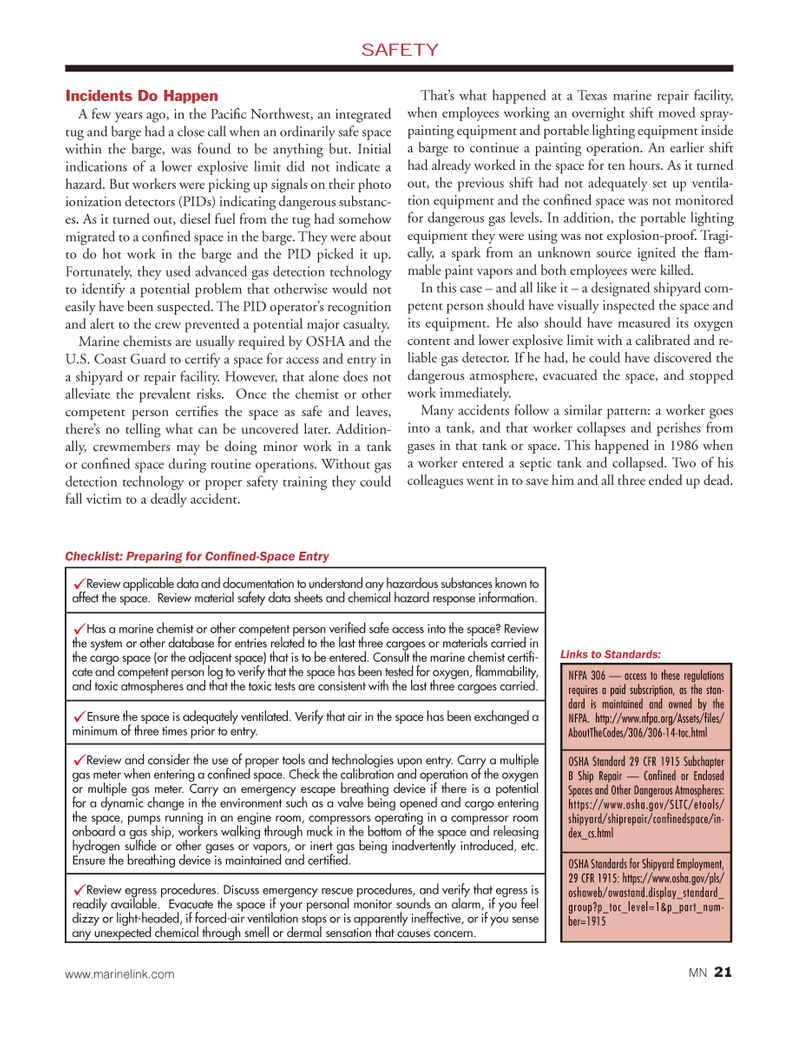
Page 21: of Marine News Magazine (October 2014)
Innovative Products & Boats - 2014
Read this page in Pdf, Flash or Html5 edition of October 2014 Marine News Magazine
SAFETY
Incidents Do Happen
A few years ago, in the Pacifi c Northwest, an integrated tug and barge had a close call when an ordinarily safe space within the barge, was found to be anything but. Initial indications of a lower explosive limit did not indicate a hazard. But workers were picking up signals on their photo ionization detectors (PIDs) indicating dangerous substanc- es. As it turned out, diesel fuel from the tug had somehow migrated to a confi ned space in the barge. They were about to do hot work in the barge and the PID picked it up.
Fortunately, they used advanced gas detection technology to identify a potential problem that otherwise would not easily have been suspected. The PID operator’s recognition and alert to the crew prevented a potential major casualty.
Marine chemists are usually required by OSHA and the
U.S. Coast Guard to certify a space for access and entry in a shipyard or repair facility. However, that alone does not alleviate the prevalent risks. Once the chemist or other competent person certifi es the space as safe and leaves, there’s no telling what can be uncovered later. Addition- ally, crewmembers may be doing minor work in a tank or confi ned space during routine operations. Without gas detection technology or proper safety training they could fall victim to a deadly accident.
That’s what happened at a Texas marine repair facility, when employees working an overnight shift moved spray- painting equipment and portable lighting equipment inside a barge to continue a painting operation. An earlier shift had already worked in the space for ten hours. As it turned out, the previous shift had not adequately set up ventila- tion equipment and the confi ned space was not monitored for dangerous gas levels. In addition, the portable lighting equipment they were using was not explosion-proof. Tragi- cally, a spark from an unknown source ignited the fl am- mable paint vapors and both employees were killed.
In this case – and all like it – a designated shipyard com- petent person should have visually inspected the space and its equipment. He also should have measured its oxygen content and lower explosive limit with a calibrated and re- liable gas detector. If he had, he could have discovered the dangerous atmosphere, evacuated the space, and stopped work immediately.
Many accidents follow a similar pattern: a worker goes into a tank, and that worker collapses and perishes from gases in that tank or space. This happened in 1986 when a worker entered a septic tank and collapsed. Two of his colleagues went in to save him and all three ended up dead.
NFPA 306 — access to these regulations requires a paid subscription, as the stan- dard is maintained and owned by the
NFPA. http://www.nfpa.org/Assets/fi les/
AboutTheCodes/306/306-14-toc.html
OSHA Standard 29 CFR 1915 Subchapter
B Ship Repair — Confi ned or Enclosed
Spaces and Other Dangerous Atmospheres: https://www.osha.gov/SLTC/etools/ shipyard/shiprepair/confinedspace/in- dex_cs.html
OSHA Standards for Shipyard Employment, 29 CFR 1915: https://www.osha.gov/pls/ oshaweb/owastand.display_standard_ group?p_toc_level=1&p_part_num- ber=1915 �9
Review applicable data and documentation to understand any hazardous substances known to affect the space. Review material safety data sheets and chemical hazard response information. �9
Has a marine chemist or other competent person verifi ed safe access into the space? Review the system or other database for entries related to the last three cargoes or materials carried in the cargo space (or the adjacent space) that is to be entered. Consult the marine chemist certifi - cate and competent person log to verify that the space has been tested for oxygen, fl ammability, and toxic atmospheres and that the toxic tests are consistent with the last three cargoes carried. �9
Ensure the space is adequately ventilated. Verify that air in the space has been exchanged a minimum of three times prior to entry. �9
Review and consider the use of proper tools and technologies upon entry. Carry a multiple gas meter when entering a confi ned space. Check the calibration and operation of the oxygen or multiple gas meter. Carry an emergency escape breathing device if there is a potential for a dynamic change in the environment such as a valve being opened and cargo entering the space, pumps running in an engine room, compressors operating in a compressor room onboard a gas ship, workers walking through muck in the bottom of the space and releasing hydrogen sulfi de or other gases or vapors, or inert gas being inadvertently introduced, etc.
Ensure the breathing device is maintained and certifi ed. �9
Review egress procedures. Discuss emergency rescue procedures, and verify that egress is readily available. Evacuate the space if your personal monitor sounds an alarm, if you feel dizzy or light-headed, if forced-air ventilation stops or is apparently ineffective, or if you sense any unexpected chemical through smell or dermal sensation that causes concern.
Links to Standards:
Checklist: Preparing for Confi ned-Space Entry www.marinelink.com MN 21
MN Oct14 Layout 18-31.indd 21 9/19/2014 4:39:10 PM

 20
20

 22
22
